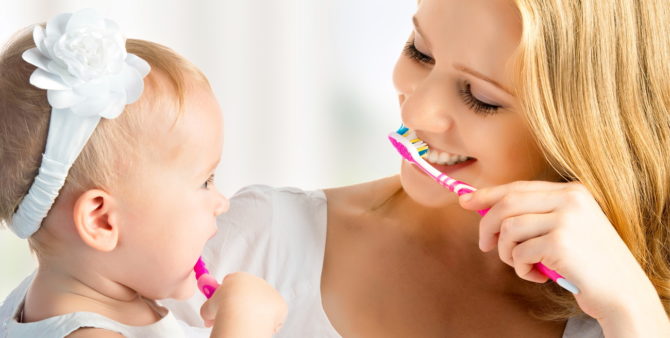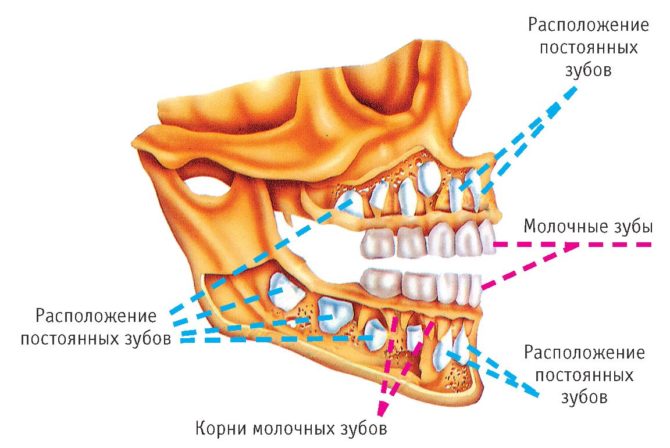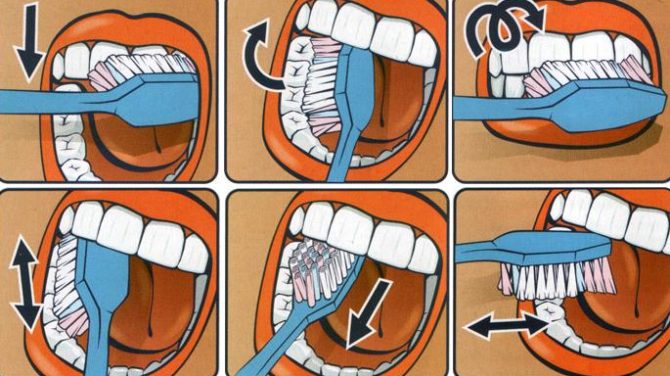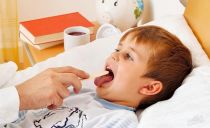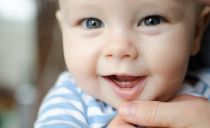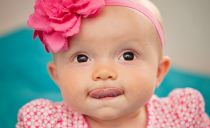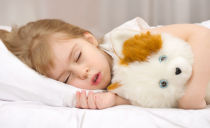How to brush your teeth for children under one year and older, at what age you need to start
Not all parents know how to brush their children properly, but the condition of erupted constants depends on the quality of care for baby teeth. To protect the child from problems with molars, incisors and fangs, it is necessary to accustom him to cleaning and rinsing his mouth after teething the very first tooth.
Content
- Features of the structure of primary teeth
- How to clean the mouth of a baby
- At what age should a child start brushing his teeth
- How many times a day do children need to brush their teeth
- How to brush children teeth
- Toothpastes for one year old babies and babies
- Teeth brushing technique with paste
- Conditioners for the smallest
- How to teach a child to brush their teeth
Features of the structure of primary teeth
Milk teeth are formed at the sixth week of fetal development. Normally there are 20 of them:
- 8 molars;
- 8 incisors;
- 4 fangs.
Temporary teeth consist of the same tissues as the permanent ones:
- dentin (in temporary teeth, it is softer and less mineralized);
- enamels;
- pulp.
However, milk incisors, canines and molars have features:
- low crowns;
- large distance between crowns;
- long thin roots that dissolve before the loss of a temporary tooth and eruption of a permanent one;
- thin enamel - only 1 mm;
- wide channels.
The structure of milk teeth is only slightly different from permanent teeth, so they no less need proper care. You can start brushing your child’s teeth after cutting the very first incisor. Early accustoming to hygiene will be an excellent prevention against many dental diseases that can affect milk incisors, and then the beginnings of the permanent ones formed under them.
If you do not take care of the teeth of the baby or take care of them incorrectly, already in the first three years of life, the baby will have to visit pediatric dentists. Or it can tolerate drilling of decayed teeth with boron, which is painful and unpleasant for a small child, even under conditions of high-quality anesthesia.
How to clean the mouth of a baby
Immediately after discharge from the hospital, you must begin to wipe the gums of the newborn baby with a dense gauze swab dipped in water. You can also wet the swab in:
- chamomile infusion, if the baby does not have constipation;
- bactericidal infusion of sage;
- a decoction of St. John's wort, as this plant strengthens the gums;
- anti-inflammatory broth of calendula.
It is not recommended to use decoctions and infusions of herbs for treating the oral cavity of infants more often 2-3 times a week, since abuse of them can lead to allergic reactions.
Hygiene, which involves treating the oral mucosa with a gauze swab, is necessary for those newborns who are breast-fed, and those babies who feed on artificial mixtures. Breast milk does not cleanse the oral cavity, but contaminates it. If you do not sanitize the baby’s mouth after feeding, then pathogenic bacteria will begin to multiply in it, which is fraught with infection of tooth enamel.
At what age should a child start brushing his teeth
The baby needs to start brushing his teeth from the moment when they begin to erupt. At first, it is better to perform manipulations without paste, carefully treating not only the first tooth, but also the gum itself. You can use a special soft children's brush or silicone pad, worn on the finger of the parent.The last device will serve not only as a brush, but also as a gum massager, which will ease the pain from teething.
To act in the cleaning process should be careful, since the gum near the cutting tooth is inflamed and sore, so babies can react poorly to a hygienic procedure. But you can’t refuse it: during teething local immunity worsens, therefore, the risk of infection of enamel increases.
For more information about caring for the oral cavity of a newborn, see the video:
How many times a day do children need to brush their teeth
Both milk and molars should be brushed twice a day. - in the morning and in the evening. Otherwise, under the influence of salts, acids and sugar, which are in the remnants of food, decay forms on milk teeth, which will have to be treated by a dentist using professional tools.
How to brush children teeth
There are several general rules for high-quality brushing, depending on the age of the baby:
- A child under one year old needs to brush his teeth using a special silicone pad that is fixed to the index finger or thumb of the parent.
- After a year, you can use a brush with silicone fibers and a special limiter, gradually switching to classic models.
- From three years old, an ordinary brush with soft villi is used. It is important that only two tooth crowns cover its surface, otherwise the hygienic procedure will not be effective enough.
The baby brush must be changed every 3-4 months. If the service life has not yet expired, but the brush has already become rough along the edges, you should change it, since pathogenic bacteria can begin to form and multiply between the villi.
How to brush your teeth for a child under 1 year old
Six months is the age when parents should start brushing their child's teeth daily. From 6 to 12 months, the teeth are cut in children, so during this period it is necessary to sanitize their oral cavity very carefully. The baby cannot take part in the hygiene procedure, but she can already express her dissatisfaction with sounds and gestures, so an adult should focus not only on the technique of dental cleaning, but also on the sensations of the baby.
How to clean the first teeth
Key cleaning rules:
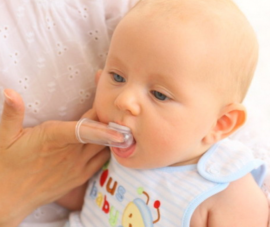 the necessary movements should be sweeping: from the root to the apex;
the necessary movements should be sweeping: from the root to the apex;- a finger with a silicone nozzle should be in the child’s mouth at an angle of 45 degrees to the gums;
- when processing chewing surfaces, the finger with the nozzle is located horizontally and cleans the crown with translational longitudinal movements;
- the inner tooth surface is cleaned with short, quick movements;
- lateral teeth can be cleaned in a circular motion.
For each tooth should be about 10-15 movements. During the procedure, it is necessary to clean not only the dental enamel, but also the inner surface of the cheeks, tongue and gums. You can also brush your teeth to a one-year-old child using special dental or dental wipes, which can be purchased at a pharmacy.
Why you need to teach your child to brush his teeth earlier than one year
It is necessary to begin to clean the baby’s milk teeth when the first incisor appears or before its complete teething. Full oral care will help:
- to form the correct bite;
- well clean the oral cavity of cariogenic bacteria;
- prevent various diseases, including caries.
How to brush teeth for children over one year old
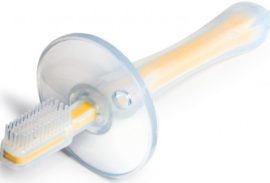 For a child older than 1 year, you can purchase the first toothbrush with silicone villi. It costs more than usual, but such a waste of money is justified: a brush with a silicone pile will not injure the child’s teeth and will help to clean the gums and cheeks. With it, you can even clean the first teeth of a child. However, such brushes quickly become unsuitable for safe operation, so you should not use them for a long time.
For a child older than 1 year, you can purchase the first toothbrush with silicone villi. It costs more than usual, but such a waste of money is justified: a brush with a silicone pile will not injure the child’s teeth and will help to clean the gums and cheeks. With it, you can even clean the first teeth of a child. However, such brushes quickly become unsuitable for safe operation, so you should not use them for a long time.
Rules for the care of children's toothbrushes with silicone bristles
In order for the silicone brush to last longer, the following rules for its operation must be observed:
- you can not boil and even just blow the brush with boiling water;
- after each use, wash it with soap (baby, tar, household).
Do not put the brush in the case, you should store it in a closed cabinet, in a glass, separately from the brushes of adult family members.
Toothpastes for one year old babies and babies
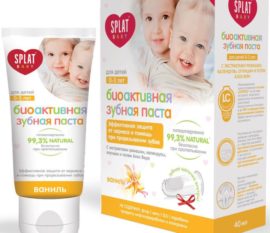 To start brushing children's teeth with paste, it is not necessary to wait until the child is one or three years old. Most pastes are indicated for children over 2 years of age, however, there are a number of manufacturers whose product line includes good fluoride-free toothpastes suitable for children under one year of age. They are completely harmless and can be swallowed. Such products can be found among brand products:
To start brushing children's teeth with paste, it is not necessary to wait until the child is one or three years old. Most pastes are indicated for children over 2 years of age, however, there are a number of manufacturers whose product line includes good fluoride-free toothpastes suitable for children under one year of age. They are completely harmless and can be swallowed. Such products can be found among brand products:
- R.O.C.S.
- Elmex
- Splat.
- Lacalut.
Each paste indicates at what age it is approved for use - you need to brush your child’s teeth only with a product that is not contraindicated for him and suitable for comprehensive care of children's teeth.
Starting to brush the teeth of a child up to one year old with the use of paste, it is necessary to monitor his reaction. Some babies may start allergies, so with the first symptoms of a rash or an incomprehensible cough, you should stop using the paste and show the baby to the doctor.
Teeth brushing technique with paste
You can start brushing your teeth with toothpaste when the child has the first incisor, the deadline is a year and a half. You should not wait when he develops caries due to lack of proper care.
Toothpaste brushing procedure:
- a predetermined amount of paste is applied to a pre-moistened brush;
- brush at right angles to the crowns;
- it is necessary to clean the tooth surface with sweeping movements: from the roots to the tops;
- the internal dental surface is cleaned with short movements, the brush is placed at an angle of 45 degrees;
- cutting and chewing surfaces of crowns are processed at the very end;
- after the procedure, rinse your mouth with water;
- the approximate duration of each cleaning is 2-3 minutes.
2-3 years old is the age when you need to start accustoming a child to brush his teeth on his own.
Conditioners for the smallest
Manufacturers of mouthwashes do not recommend the use of such funds for children under the age of six, as there is a high risk that the baby will swallow the rinse aid.
How to teach a child to brush their teeth
Many children under 1 year old, and sometimes older children, do not want to brush their teeth, expressing their displeasure in every possible way. In this case, you need to draw their attention to the hygiene procedure using one of these methods:
- buy a bright brush with your favorite cartoon character and a toothpaste with a pleasant fruity taste;
- invite the baby to brush his teeth with his toys;
- brush your teeth with your child and compete with him in quality and speed of brushing.
Each parent independently decides at what age to start brushing the child’s teeth and whether to use a paste, but delay can adversely affect the health of the crumbs. Parents should not only brush their children’s teeth, but also teach them how to properly care for their oral cavity.
In more detail about children's teeth, caring for them and teaching a child to brush, Dr. Komarovsky tells in a video:

